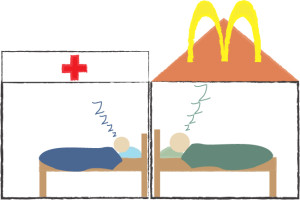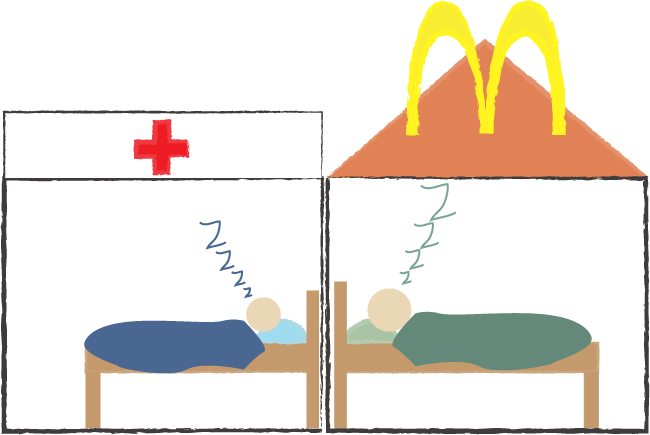In preparation for this past Easter, the Ronald McDonald House at Stanford decorated its front office with yellow ducks and colored eggs. The children’s books and stacks of parenting brochures in the front office reinforced the youth-oriented atmosphere, offering a hint at the house’s residents.

Located across the street from the Stanford Shopping Center, the Ronald McDonald House at Stanford provides food and housing for young patients at the Lucile Packard Children’s Hospital and their families, most of whom live over fifty miles away.
The Stanford house, the fifth Ronald McDonald House in the country, opened its doors in May 1979.
“Local McDonald’s owner/operators found that the children’s hospital at Stanford was one of the growing markets for children’s health and felt that this would be a good location,” said Linda Lyon, the development director of the Ronald McDonald House at Stanford. “At the time, the children’s hospital was right next door.”
The house, which will be undergoing an expansion in the coming months to almost double its size, is an independent nonprofit 501(c)(3) organization that leases its land from Stanford for one dollar per year.
“A little less than 10 percent of our profit comes from the families who stay with us, some medical insurance companies or California Children’s Services,” Lyon said. “They pay our requested amount of $10 per night.”
According to Lyon, the remaining 90 percent of funding comes from the support of the community. Of that, about 6 percent comes from local McDonald’s owners and operators, while 84 percent comes from corporations, foundations and donors.
The average length of stay at the house has grown over the years from a few days to 24. The longest continuous stay was over two and a half years, according to Lyon. The house is especially important for families of patients undergoing lengthy treatments such as organ transplants.
“The child will need to be here pre-operatively when they’re on the transplant list, keeping up their health while they’re waiting,” Lyon said. “Then the child is in the hospital for the transplant and immediately after, and then the child comes back for recovery and daily check-ups until the doctor says they can go home. Even though we might have a five-month visit, the child might only be in the hospital for a week.”
In addition to food and boarding, the house offers arts and crafts, activities and other recreational events for the patients and their siblings. Stanford athletic teams often come and help organize tournaments with the children, while other Stanford-affiliated volunteers come in four to six nights a week to cook dinner for the families. The house is staffed by 150 volunteers, saving the house $300,000 in labor costs each year.
Xianne Penny ‘12 Ph.D. ‘12 P.D., a postdoctoral fellow of pathology, spearheaded a crane chandelier project that was completed in November of 2009. The chandelier consists of 6,873 paper cranes and is currently hung in the Great Hall, the main lounge of the house.
“We did it because it was inspired by a Dale Chihuly glass-blown chandelier at the Mayo Clinic [in Rochester, Minn.],” Penny said. “His inspiration was for people who entered the clinic to look up and, for a moment, forget their pain and suffering. That’s what we wanted to do with the paper crane chandelier.”
Penny’s volunteering experiences at the house did not start out on such a positive note. She first volunteered at the house on a weekly basis, helping with their Make a Book Day, a program in which children at the house made a book out of various arts and crafts supplies.
“The patients themselves find it hard to put colored cotton balls together on a page when they are in wheelchairs,” she said. “It’s frustrating for them to make something creative and not be able to do it to the best of their ability because they are sick.”
The program did not last long, and attendance dwindled. However, Penny soon started participating in activities like the Big Sur Marathon, which raises money for the house. The marathon was to be a more successful foray into volunteerism.
“I did [the Big Sur Marathon] for three years in a row,” she said. “This past year I got married the same day as the run.”
In fact, Penny had become so used to running the marathon that she wanted to run on the morning of her own wedding and get to the church on time for the afternoon ceremony, though she ultimately took the year off from participating,
Penny emphasized that the house gives her the opportunity to interact with patients and their families and witness their hope.
“There was a boy who had been waiting for a heart transplant for two and a half years,” Penny said. “Every time I saw him his face was bluer. Sometime while we were hanging the paper chandelier he got a call from the hospital saying there’s a heart.”
The volunteer work that Penny and others contribute to the organization provide necessary services for parents like Kim Furnish, a former resident of the house, who stayed there for four months while her 17-month-old daughter was being treated at the hospital.
“The doctors wanted us 15 minutes from the hospital,” Furnish said. “We panicked, not knowing what to do. Some of the hotels in the area are $300 a night, and we were looking for a long-term stay.”
The Ronald McDonald House fulfills a larger purpose than just providing a physical place for families of patients to stay — it serves as a home away from home, with the volunteer community, the accommodating staff and the other parents themselves all acting as a support network.
“Our friends at home don’t get what being a parent of a critically ill child is all about, but the parents staying at the Ronald McDonald House get it,” Furnish said. “The families that you meet there and the support from other parents are overwhelming. It’s a real magical place.”
